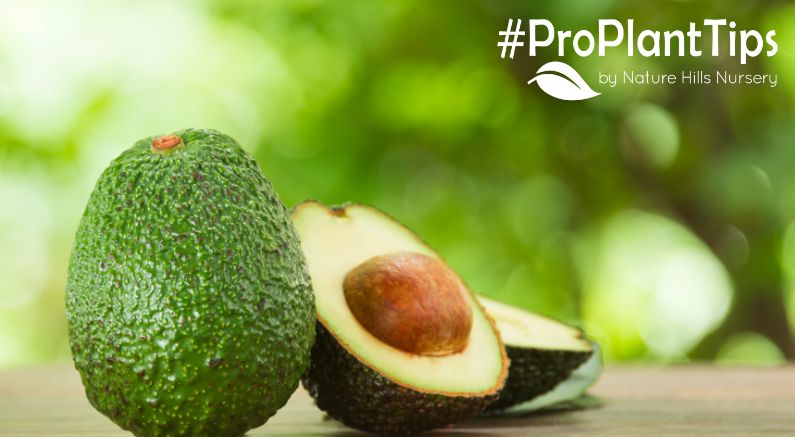The lovely form, bountiful flowers, and adaptable structure of the Avocado tree make it an excellent ornamental tree! The tropical broad-leaved evergreens are fantastic and easy to grow!
Learn how to grow a high yield of these fantastic rich and nutritious fruit trees in your own landscape and discover all the joys of these dual-purpose trees that add privacy, year-round greenery, shade, unique blooms, and unique specimens around your property!
About Avocado Trees

Originally from central Mexico, Central America, and Asia, the Avocado tree (Persea) is now cultivated across a range of tropical and Mediterranean countries. The tree arrived in the U.S. sometime in the 1830s, and it remains an important cash crop in California.
Avocado fruits are somewhat like bananas, in that they mature on the tree, are harvested, and then ripen. Fruit skins may be green, brown, purplish, or black and take an ovoid or spherical shape. The flesh is light green and buttery when ripe with one large pit or seed.
Ripening later in the growing season in the fall to the winter in USDA growing zones 9 and up. The bumpy green skin has given Avocados the nickname Alligator Pears. The flesh is smooth and buttery in consistency and often green to yellow to almost creamy white.
They can be grown as single-stem trees or many like to grow them as large shrubs or low-branched plants for screening and hedgerows. Shrub form plants are much easier to harvest if your landscape permits. Try a Little Cado Dwarf Avocado, or prune another Avocado to size to fit in a pot better!
Avocado Tree Care
Are Avocado trees hard to take care of?
Like all fruit trees, Avocado trees need full sun (at least 6 hours of sun a day) to flower and fruit the best.
These trees are very sensitive to poor draining soils and care must be given when planting. If soil drainage is a concern, mound or build a raised bed at least 12 to 18 inches above the soil line and plant in the raised bed. The Avocado's root system is also sensitive to being disturbed. Take care when transplanting not to damage or disrupt the roots and ensure you plant your tree where you want it permanently.
Avocados can be grown as a houseplant but will not produce fruit as an indoor/outdoor plant under normal circumstances and need very bright light and well-drained soil. They do very well in a greenhouse setting! They can, however successfully produce fruit in containers in a heated greenhouse. If planted in a pot, an Avocado tree may be pruned to regulate its mature size.

In Zone 9, Avocados will require occasional protection from the cold, so a southwest-facing exposure with good winter air circulation is recommended.
Avocados are heavy-feeding plants and are sensitive to micronutrient deficiencies. Check your soil nutrients and pH through soil testing on your own or contact your County Extension Office.
Avoid this by applying a balanced Organic Fertilizer such as Dr. Earth Life Organic and Natural All-Purpose Fertilizer quarterly. But be careful not to over-fertilize your tree and keep lawn fertilizer away from your tropical fruit tree.
Remember to mulch your Hass Avocado 3-4 inches deep to the outside of the canopy and be careful not to overwater.

Selecting the best location to plant is your best advantage against the cold. Choose locations that have good air movement but are not exposed to high winds and avoid low locations where cold collects during the fall and winter. In marginal Avocado locations, select a wall of the house or a south-facing wall that radiates heat to add protection to your plants.
Avocados are not recommended for planting in the ground in Zone 8 and lower and do well in Zones 9 and up. They are fantastic in pots and planters on sun-drenched porches! Northern growers can even enjoy these as lovely patio plants that can be brought indoors during cold snaps and for the winter. Add some caster wheels to make moving them into a garage or enclosed patio or greenhouse during the cold times of the year.
Prune in the late winter or very early spring to remove dead wood and crossing branches, and to control height and size. You’ll want to keep an open canopy and allow sunlight and air circulation to penetrate the trees interior.
Understanding Avocado Tree Pollination
Do you need 2 Avocado trees to produce fruit?
There are Type 'A' and Type 'B' Avocado trees regarding pollination. Type 'A-flowers' are female and can receive pollen in the morning and the same flower becomes male, producing pollen the next day in the afternoon. Type 'B flowers' start as male in the morning, and that same flower becomes female on the 2nd day in the afternoon.
Beneficial insects and bees spread pollen from bloom to bloom. The flowers appear in thousands of clusters of small, yellow flowers growing in panicles, and can be green to yellow to white in color.
Often, in USDA growing zones 9 and up, most Avocados are self-pollinating, but by planting type 'A' and 'B' trees together, you will enjoy a far larger harvest per tree.
|
Type A Avocados |
Type B Avocados |
|
|

How long does it take for an Avocado tree to bear fruit?
All of Nature Hills Avocado trees are already at least 2-3 years old and grafted onto hardy rootstock. You can expect your first harvest at 3-5 years of age!
Amazing Avocados!
Far better than the grocery store, enjoy home-grown Avocados for your whole family, grown right in your own backyard!
Rich and buttery, the unusual green fruit, and the lovely year-round greenery, Avocado trees are wonderful additions to your landscape and food sustainability! Nature Hills supplies grafted trees with hardy rootstocks to help insure disease tolerance and ample harvests.
Check out all the fantastic varieties of Avocado trees available at NatureHills.com!
Happy Planting!


